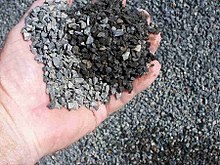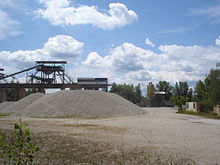Term: Construction aggregate
Definition and Importance of Construction Aggregate
– Construction aggregate is a category of coarse- to medium-grained particulate material used in construction. It includes materials such as sand, gravel, crushed stone, slag, recycled concrete, and geosynthetic aggregates.
– Aggregates are widely used in drainage applications, foundation and French drains, septic drain fields, retaining wall drains, and roadside edge drains. They are also used as base material under foundations, roads, and railroads.
– Aggregates can be used as a low-cost extender that binds with more expensive cement or asphalt to form concrete.
– Aggregates are the most mined materials in the world.
– They are a component of composite materials like concrete and asphalt, adding strength to the overall material.
– Aggregates have high hydraulic conductivity, making them suitable for drainage applications.
– They provide a stable foundation or road/rail base with predictable properties.
– They are essential for construction projects, including roads, buildings, and infrastructure.
European and ASTM Specifications for Construction Aggregate
– Sizing ranges for aggregates in Europe are specified using square mesh grating measurements. European Standard EN 13043 covers road construction sizings, EN 13383 specifies sizings for larger armour stone, EN 12620 is for concrete aggregate, EN 13242 covers base layers of road construction, and EN 13450 is for railway ballast.
– The American Society for Testing and Materials publishes specifications for construction aggregate products. ASTM D 692 and ASTM D 1073 are examples of these specifications.
– State transportation departments refine aggregate material specifications to meet their local needs and supply. These specifications include additives for asphalt and concrete mixes.
Sources of Construction Aggregate
– Aggregate sources can be grouped into three main areas: mining of mineral deposits, use of waste slag, and recycling of concrete.
– Sand, gravel, and stone are mined for aggregate.
– Slag from iron and steel manufacturing can be used as aggregate.
– Concrete can be recycled to produce aggregate.
– Some specialty lightweight aggregates include clay, pumice, perlite, and vermiculite.
Uses and Recycling of Aggregates
– Recycled glass aggregate can be used as a substitute for pea gravel or crushed rock in construction projects. It can also be used as pipe bedding and fill for leveling concrete floors.
– Recycled aggregates can be used as subbase for roads and driveways, helping contractors save on disposal costs.
– Aggregates themselves can be recycled, especially in urban areas. Mobile recycling plants eliminate the need for transportation to a central site.
– Geosynthetic aggregates made from recycled materials, including plastics, can replace conventional gravel and improve porosity and hydraulic conductivity.
– Many aggregate products are recycled for other industrial purposes, reducing disposal costs.
Recycled Aggregates in the UK and Challenges/Innovations
– In the UK, recycled aggregate is produced from processed construction material. In 2008, 67 million tonnes of recycled aggregate were produced out of a total of 210 million tonnes. The Waste and Resource Action Programme has established a Quality Protocol for regulated production.
– Using minced tires as part of concrete aggregate can result in tougher concrete, but it reduces compressive strength. Applying pressure to the concrete as it sets can improve strength. Scientists have also developed concrete with 100% tire-rubber aggregate, creating a sustainable solution.
This article needs additional citations for verification. (January 2017) |
Construction aggregate, or simply aggregate, is a broad category of coarse- to medium-grained particulate material used in construction, including sand, gravel, crushed stone, slag, recycled concrete and geosynthetic aggregates. Aggregates are the most mined materials in the world. Aggregates are a component of composite materials such as concrete and asphalt; the aggregate serves as reinforcement to add strength to the overall composite material. Due to the relatively high hydraulic conductivity value as compared to most soils, aggregates are widely used in drainage applications such as foundation and French drains, septic drain fields, retaining wall drains, and roadside edge drains. Aggregates are also used as base material under foundations, roads, and railroads. In other words, aggregates are used as a stable foundation or road/rail base with predictable, uniform properties (e.g. to help prevent differential settling under the road or building), or as a low-cost extender that binds with more expensive cement or asphalt to form concrete. Although most kinds of aggregate require a form of binding agent, there are types of self-binding aggregate which do not require any form of binding agent.





In Europe, sizing ranges are specified as d/D, where the d shows the smallest and D shows the largest square mesh grating that the particles can pass. Application-specific preferred sizings are covered in European Standard EN 13043 for road construction, EN 13383 for larger armour stone, EN 12620 for concrete aggregate, EN 13242 for base layers of road construction, and EN 13450 for railway ballast.
The American Society for Testing and Materials publishes an exhaustive listing of specifications including ASTM D 692 and ASTM D 1073 for various construction aggregate products, which, by their individual design, are suitable for specific construction purposes. These products include specific types of coarse and fine aggregate designed for such uses as additives to asphalt and concrete mixes, as well as other construction uses. State transportation departments further refine aggregate material specifications in order to tailor aggregate use to the needs and available supply in their particular locations.
Sources for these basic materials can be grouped into three main areas: mining of mineral aggregate deposits, including sand, gravel, and stone; use of waste slag from the manufacture of iron and steel; and recycling of concrete, which is itself chiefly manufactured from mineral aggregates. In addition, there are some (minor) materials that are used as specialty lightweight aggregates: clay, pumice, perlite, and vermiculite.
